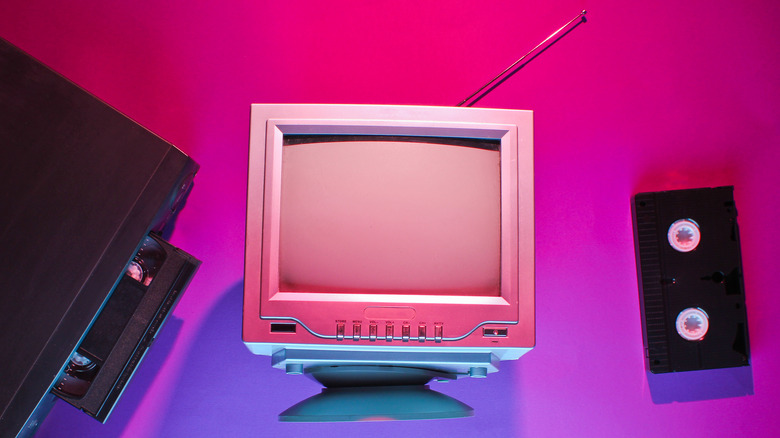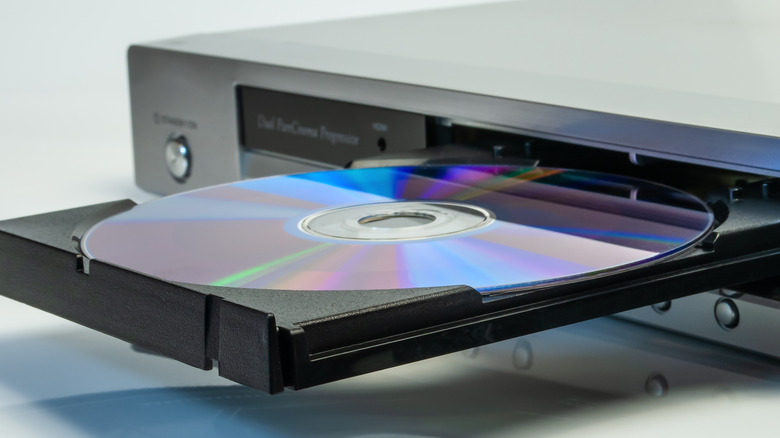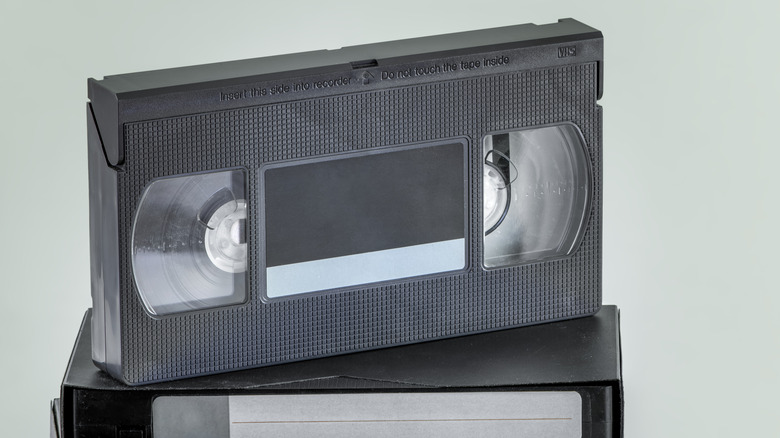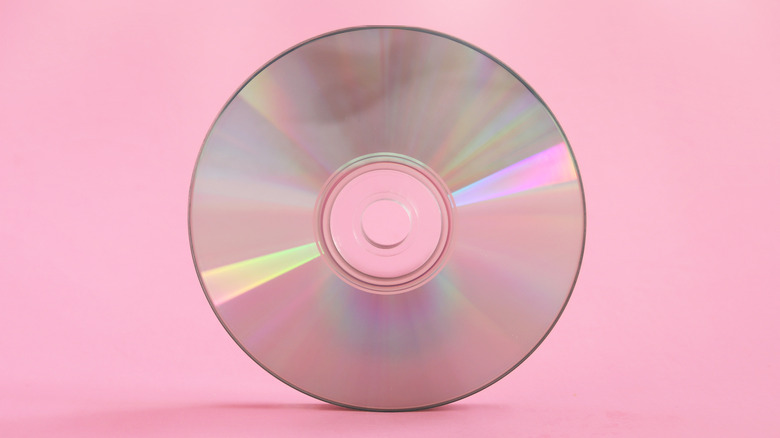The VHS Vs LaserDisc Battle Explained
When you think of the home video format of choice in decades past, what comes to mind first? For many, it's the bulky, plastic VHS tapes that dominated video rental store shelves for years. VHS tapes and the VCRs that could play them, however, weren't the only home entertainment option on the market. There was the battle between VHS and Betamax at the outset of the VHS tape's rise, and perhaps more interesting was another contender that had been vying for the home video throne: the LaserDisc.
Looking at the LaserDisc format, you might be surprised how closely it resembles the modern-day DVD considering it was quite a flop. The disc format was far superior in quality when compared to tapes, but this had no bearing on the inevitable outcome. In the end, the winning format came down to what consumers were looking for in a home video entertainment system at the time. These factors included the amount of storage available, recording ability, and ultimately, price.
What is LaserDisc?
For its time, the LaserDisc was very advanced in both visual and audio output when compared to VHS tapes. Even though overall it was an unpopular format, many home video hobbyists flocked to the LaserDisc for its superior quality. The physical medium resembled a modern DVD, though the discs were quite a bit larger with a 12-inch diameter. How did this format come about, and how does it work?
The original technology for the LaserDisc was established in a series of patents filed between the late 1950s and early 1970s, as explained by the Computer History Museum. Music Corporation of America (MCA) created its own version of this technology, which resulted in the Disco-Vision in 1978. Eventually, Japan's Pioneer took a stake in the technology and began marketing its own trademarked LaserDisc, which became the most popular version. The format didn't catch on in North America, however, and by the end of its lifespan in the 1990s, it was found only in around 2% of American homes, according to a 1998 status report from the Wisconsin Library Association.
However, the LaserDisc was much more popular in Japan and was owned by around 10% of the population before it was discontinued. This was largely due to the fact that the format was much cheaper in Japan. LaserDisc continued to be manufactured up until 2009 when Pioneer announced it planned to stop making them. Prior to that, the last LaserDisc movie released in North America was "Bringing Out the Dead" in 2000, and the last LaserDisc movie released in Japan was "Tokyo Raiders" in 2001. By this time, DVDs were all the rage and, being the grandfather of this new format, the LaserDisc couldn't compete.
What is VHS?
Video Home System videocassettes, more commonly referred to as VHS tapes, were much different than LaserDiscs and ultimately more popular. These tapes are comprised of rectangular plastic casings with a spool of tape that contains the frames of a movie or TV show. When inserted into a VCR player, light is used to read the tape, which is played on the connected TV.
Japanese company JVC created this format and released it in the U.S. in 1977. At that time, Sony's Betamax format was the most widely used option, but its video length limitations were a problem and VHS was soon to replace it. By 1980, VHS tapes dominated the home video market by 60%, as reported by TechSpot. JVC eventually licensed the format to more companies, allowing the production of many VCRs and VHS tapes.
The VHS format stayed put as the top choice for home video for many years. It wasn't until the early 2000s, when DVDs came around, that interest in them began to drop. The VHS tape format had a successful and lengthy run, but it had to come to an end as technology advanced.
Why did LaserDisc fail?
In the VHS versus Laserdisc battle, VHS was the ultimate winner even though LaserDisc had many clear advantages. Some of these benefits included its sharper picture resolution and the ability to use both analog and digital audio, plus Pioneer's VP-1000 LaserDisc player made it much easier to skip to specific parts of a movie (via Blamld). The VHS tape format, on the other hand, had some advantages of its own that inevitably proved more desirable to consumers.
One of the main selling points of VCR players was that you could set them to record television shows. This was an amazing feature in a time when consumers didn't have on-demand access to TV shows. There really wasn't a market at the time for watching movies at home, as most people were still used to going to the theater. And, even though LaserDiscs were theoretically cheaper to manufacture, the demand for VHS tapes drove their manufacturing costs down to $1 per tape, whereas LaserDiscs cost $5 per disc, according to Matt Blitz of "Today I Found Out."
Initially, LaserDiscs also could only have about 30 minutes of video and audio stored on one side, meaning for most movies you'd need to flip the disc at some point or switch out multiple discs. The VHS tape, on the other hand, could easily hold a full movie (except in certain cases like "Titanic"), making the movie-watching process much easier. VHS tapes also proved to be much more durable than LaserDiscs, which were easily scratched and unable to handle the same level of wear.
The end of both VHS and LaserDisc
Eventually, something new and shiny had to come around. DVDs soon became the best format for home video entertainment, bringing VHS to an end, as detailed by the LA Times. LaserDisc and DVDs never directly competed, since the former had long been dying out. The technology for DVDs did come from the LaserDisc era, but the newer format was seemingly infinitely cheaper to manufacture and fixed many of the issues the larger, older counterpart faced. The DVD format was able to go completely digital, erasing the various problems with analog video playback systems.
If you think about it, the LaserDisc really did get the last laugh in the home video format wars. It was always the superior format for quality, and the DVD and Blu-Ray format that followed prove this. The LaserDisc, really, was too far ahead of its time and wasn't able to overcome the obstacles it faced because of this. The now-dead VHS tape will always be the face of home video entertainment in the '80s and '90s, but the legacy of the LaserDisc lives on.




